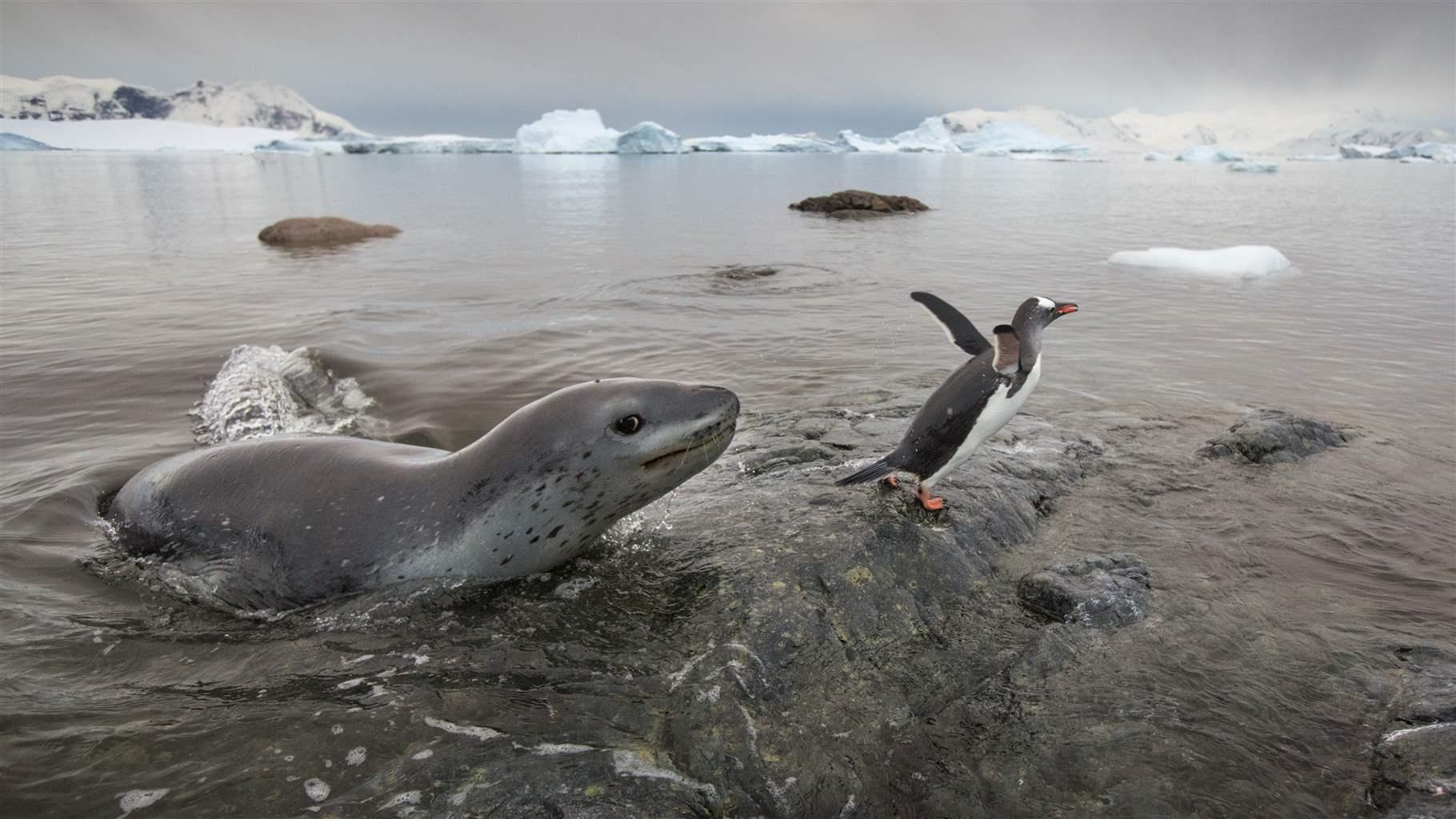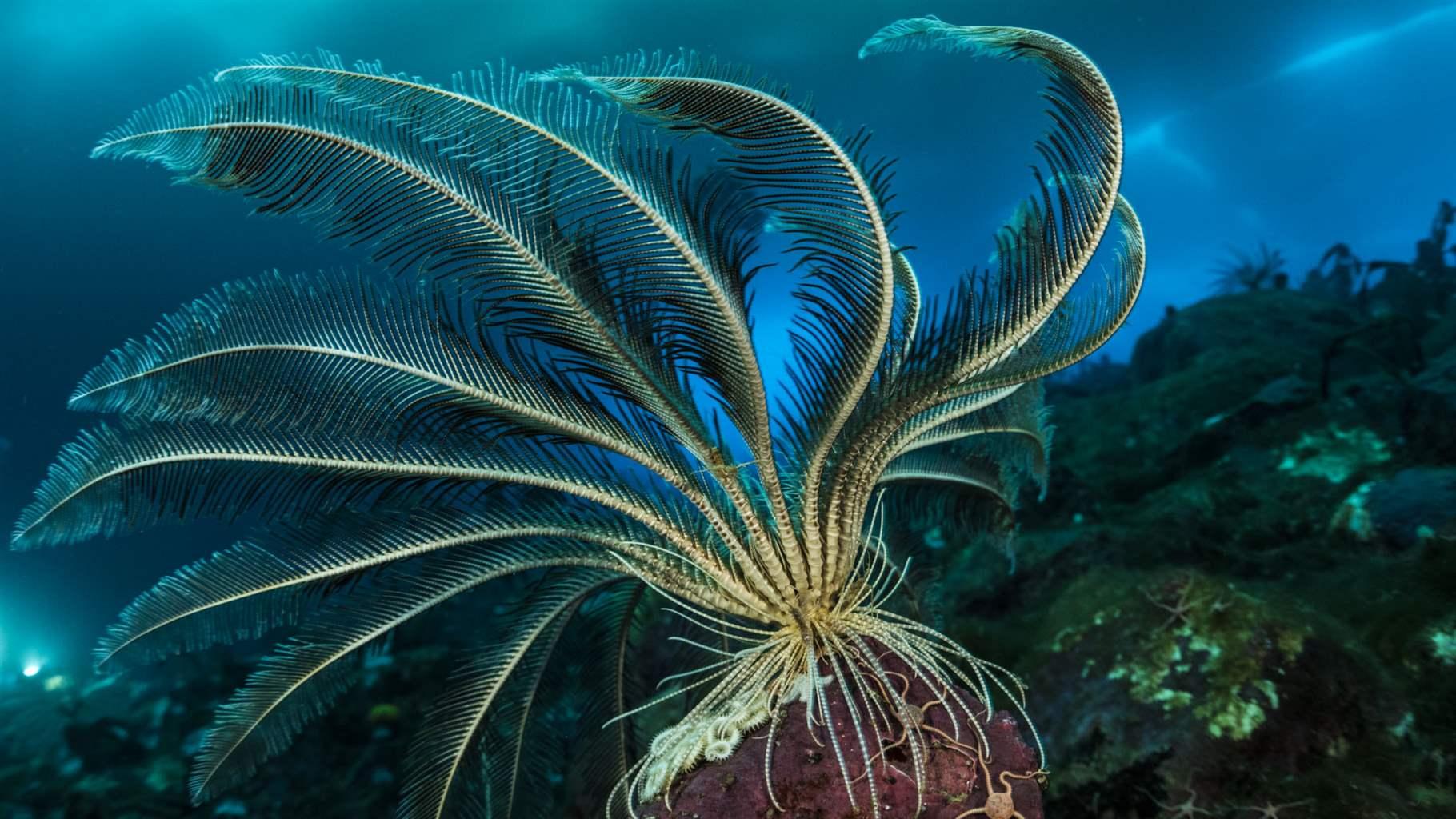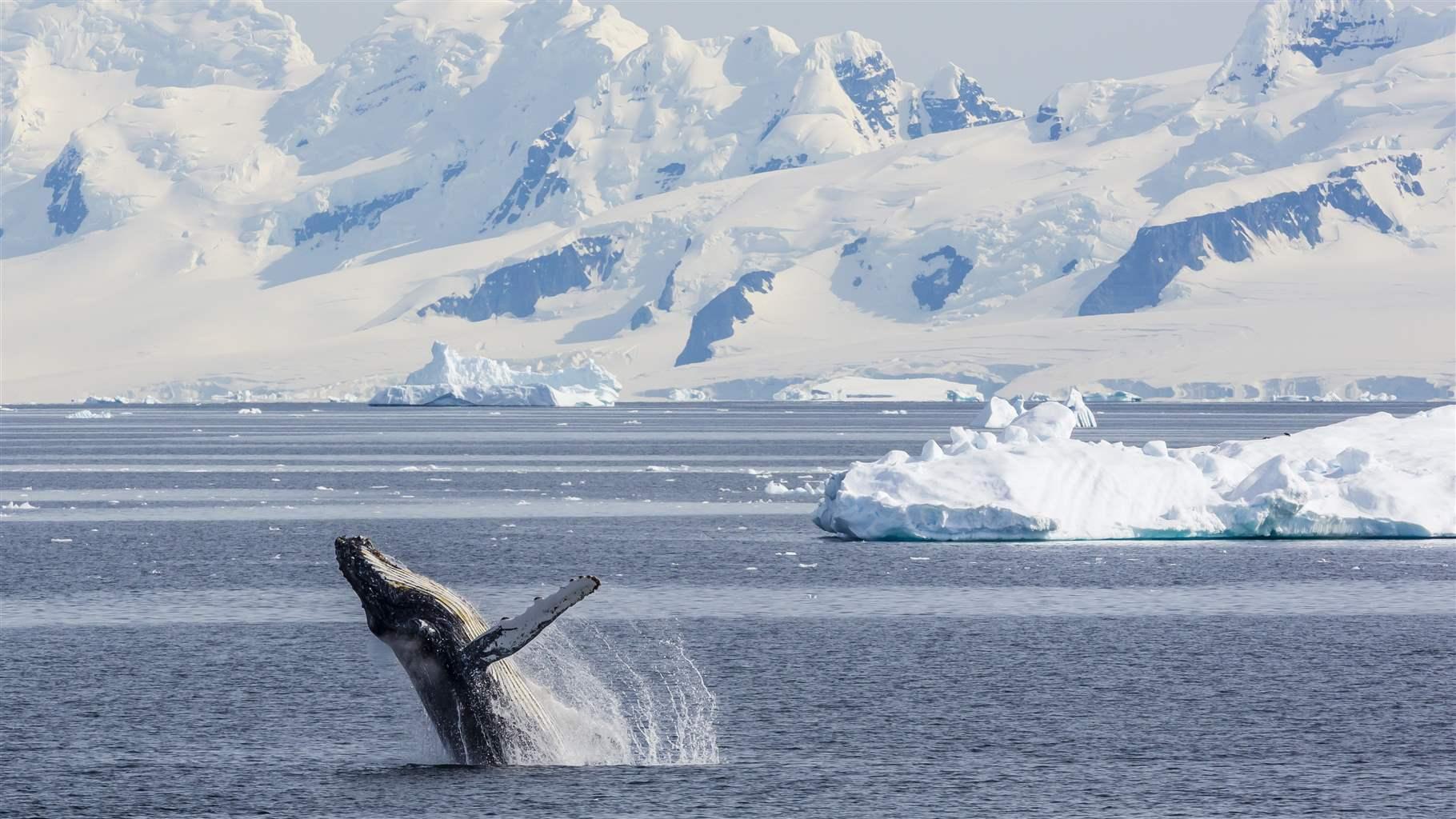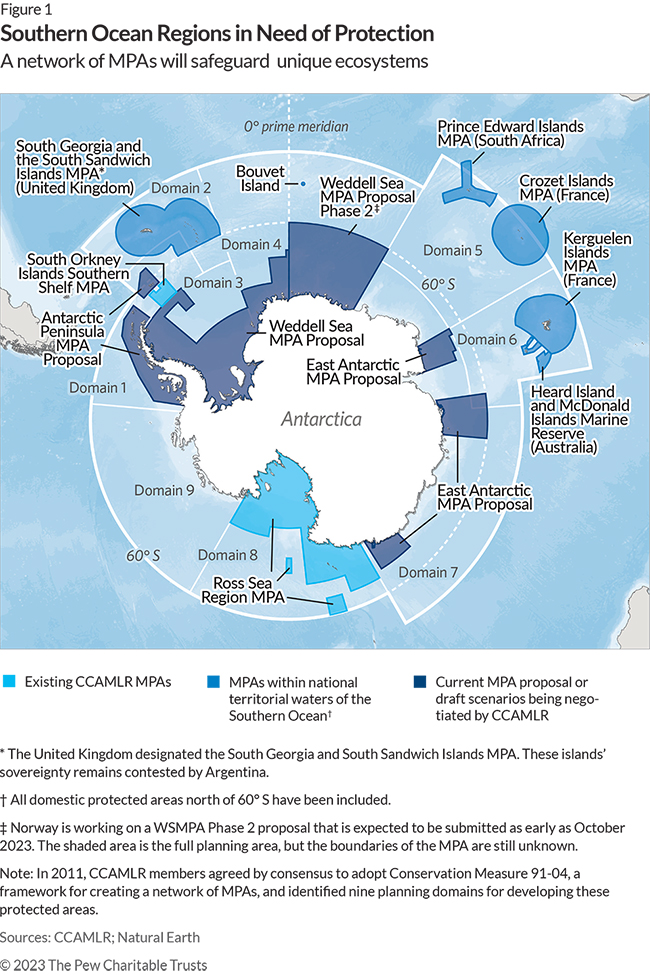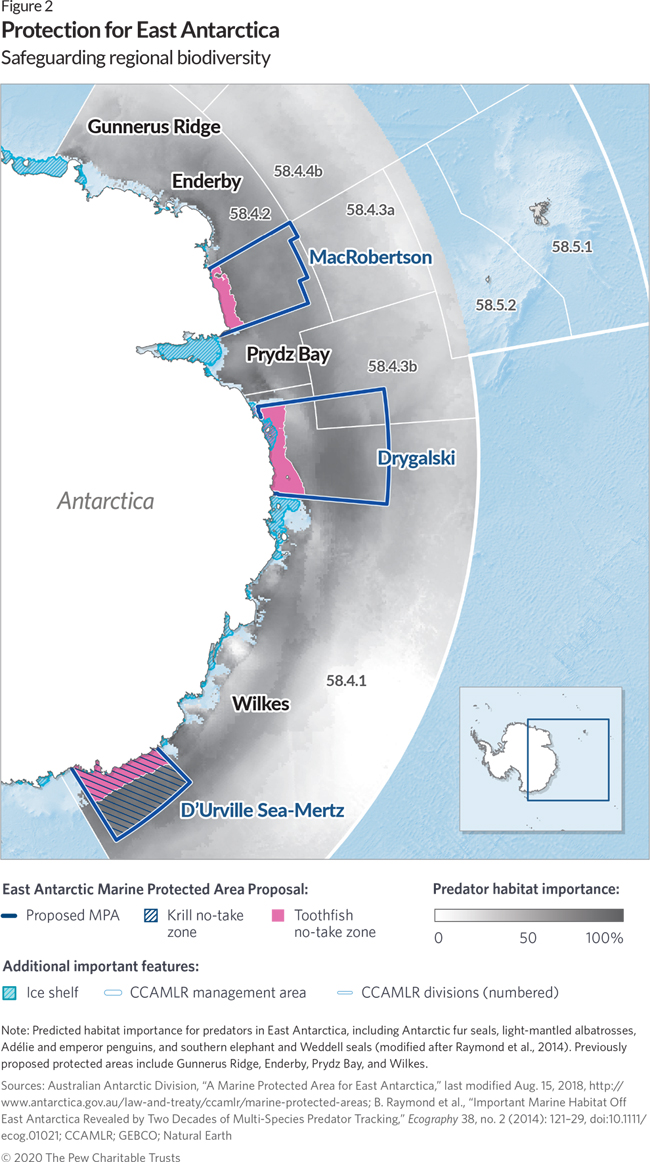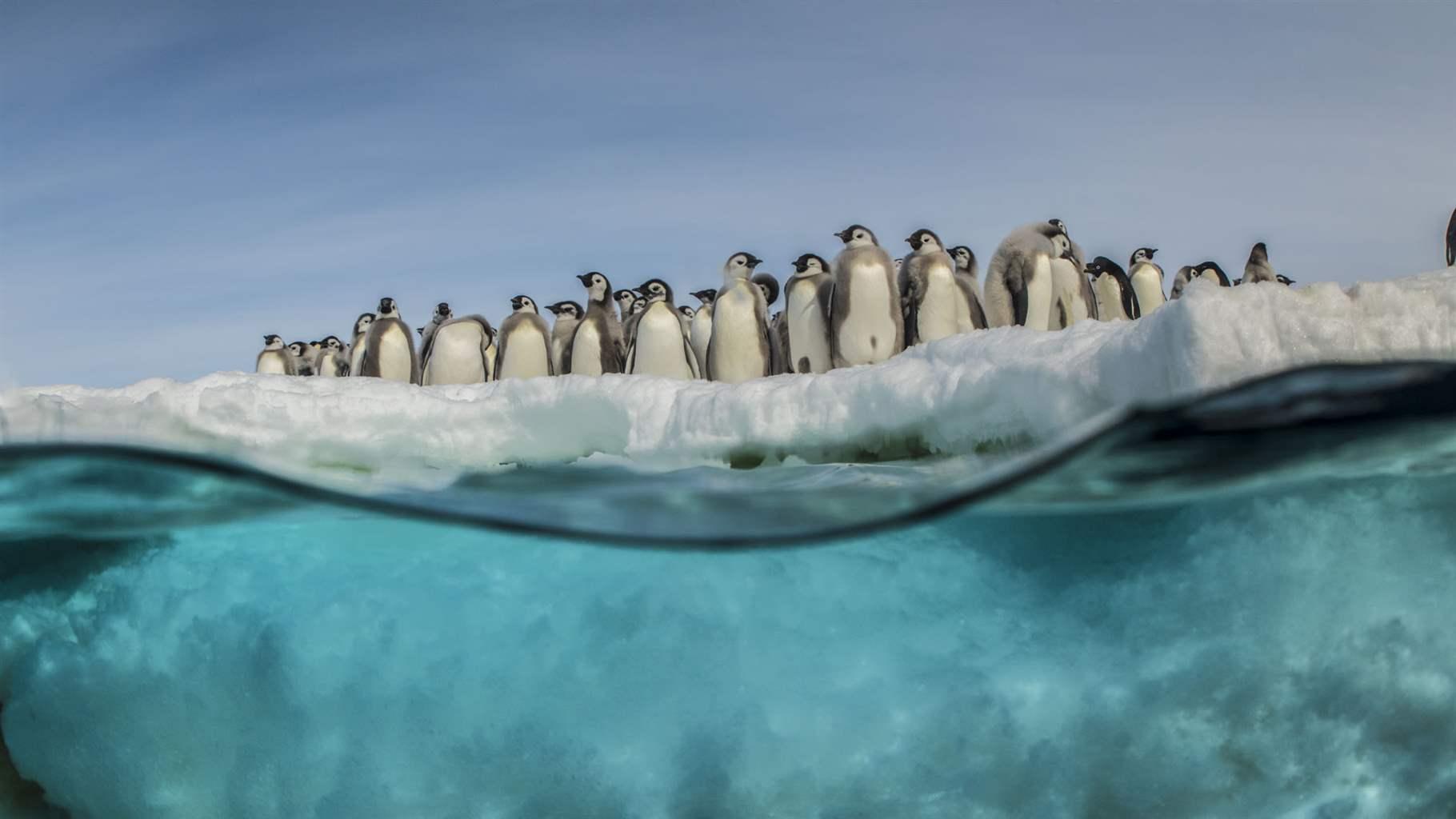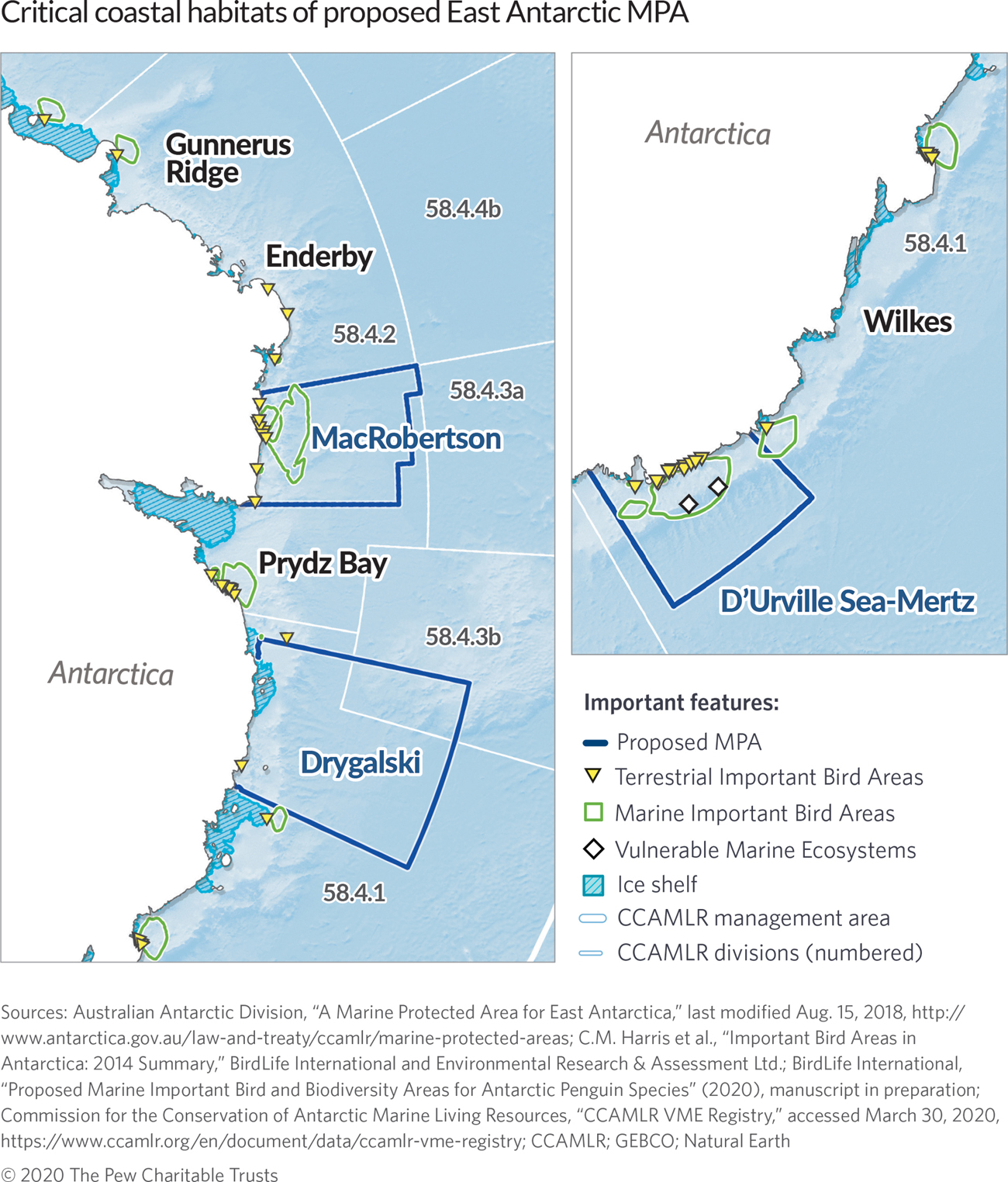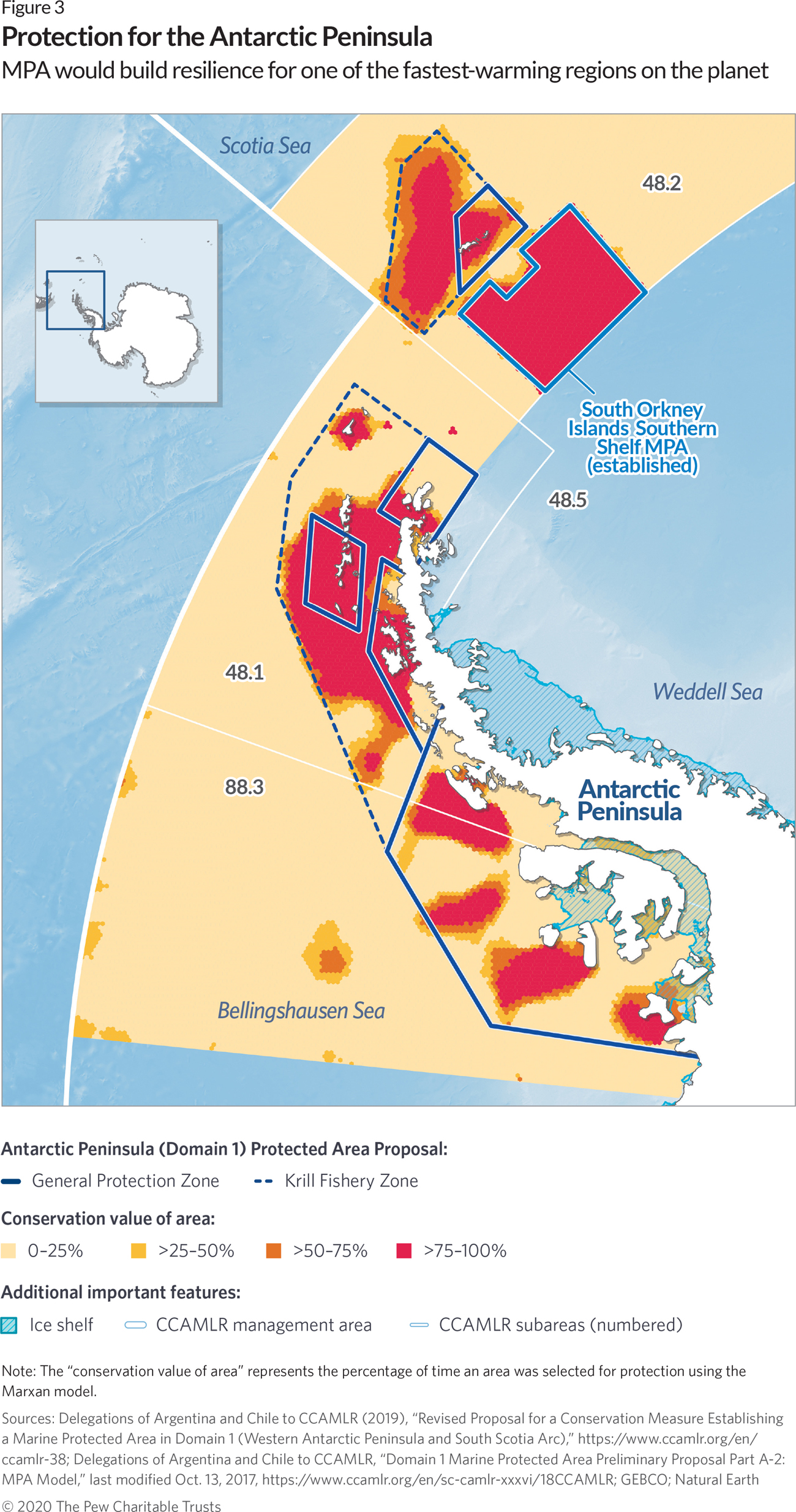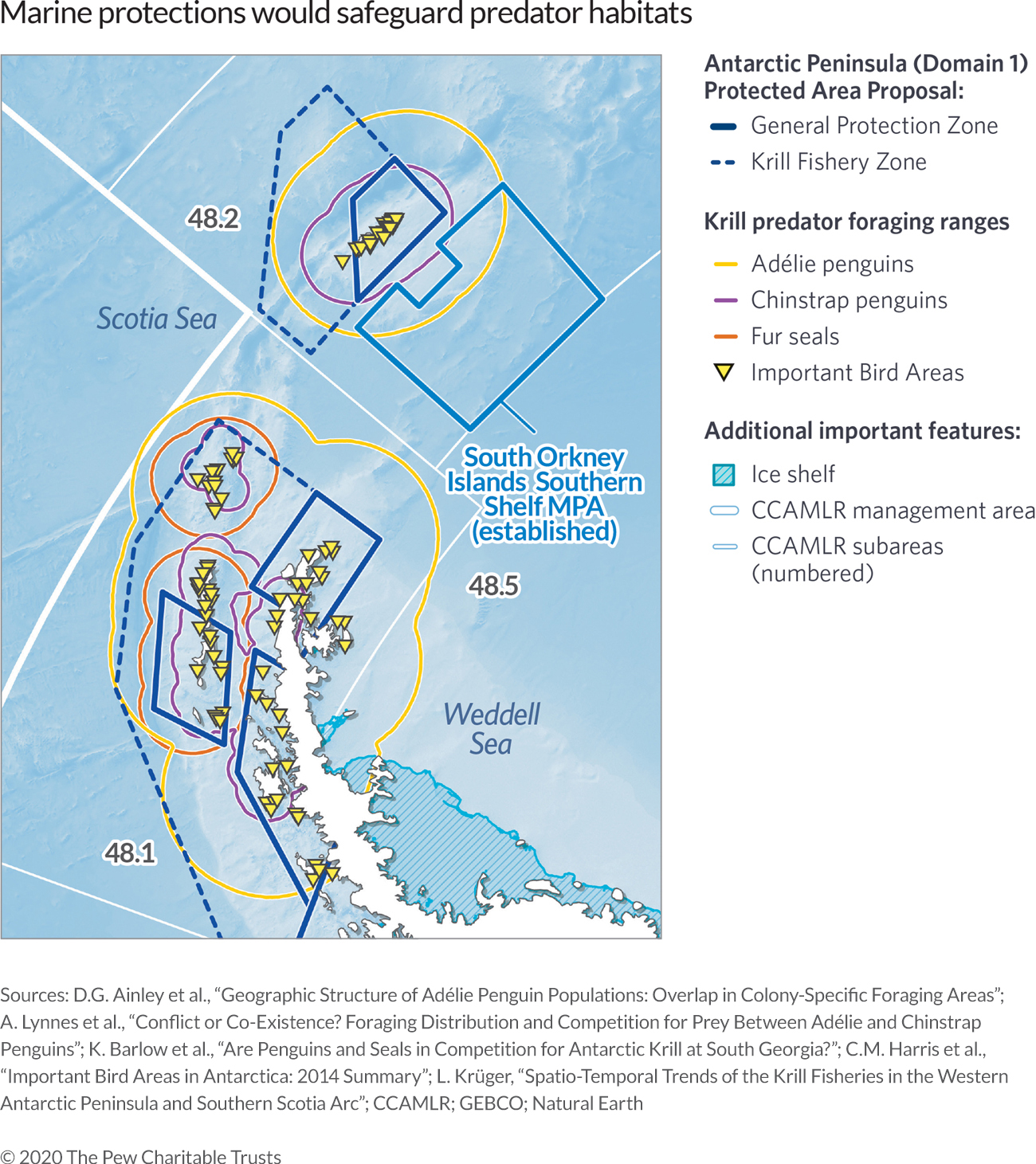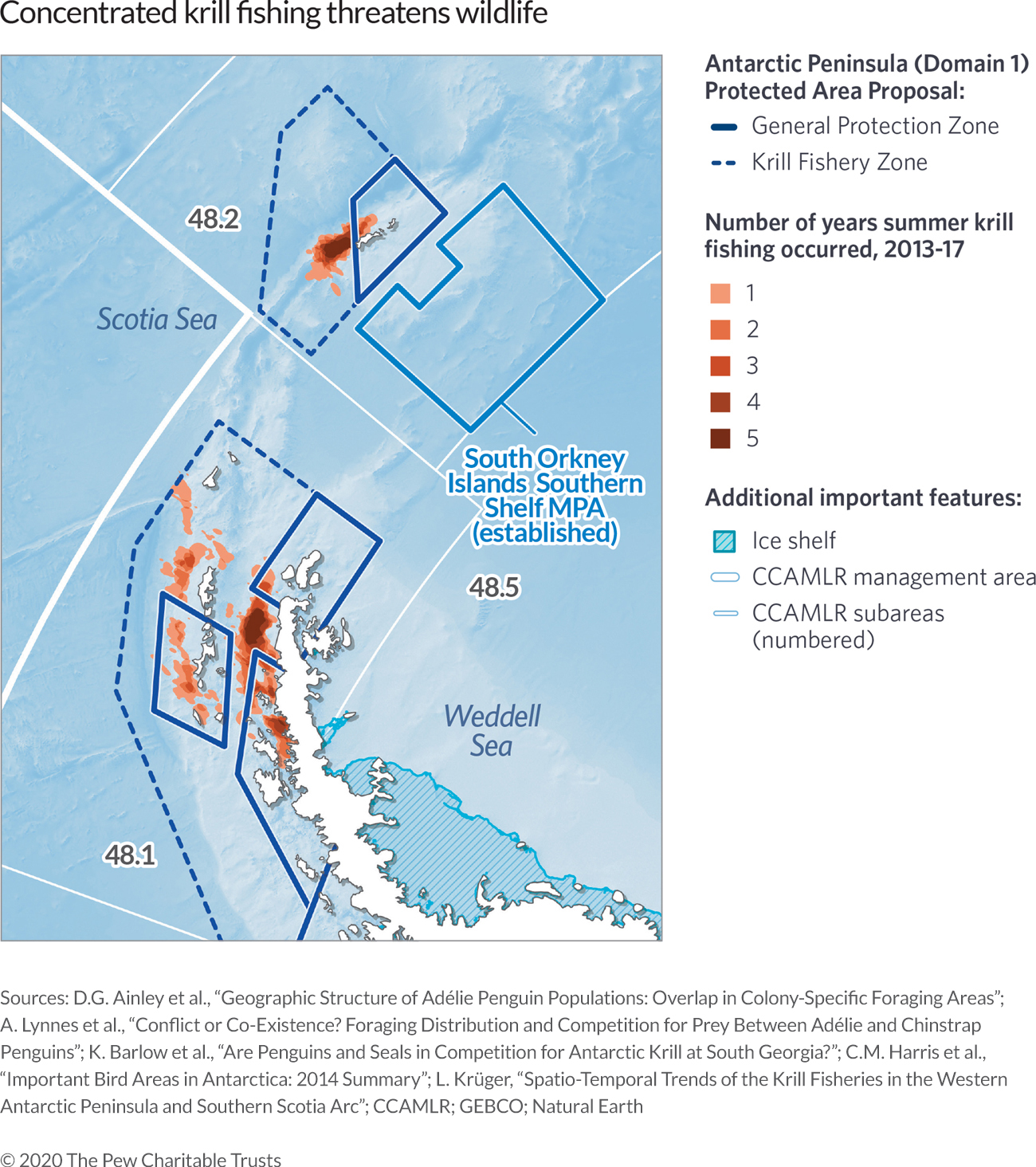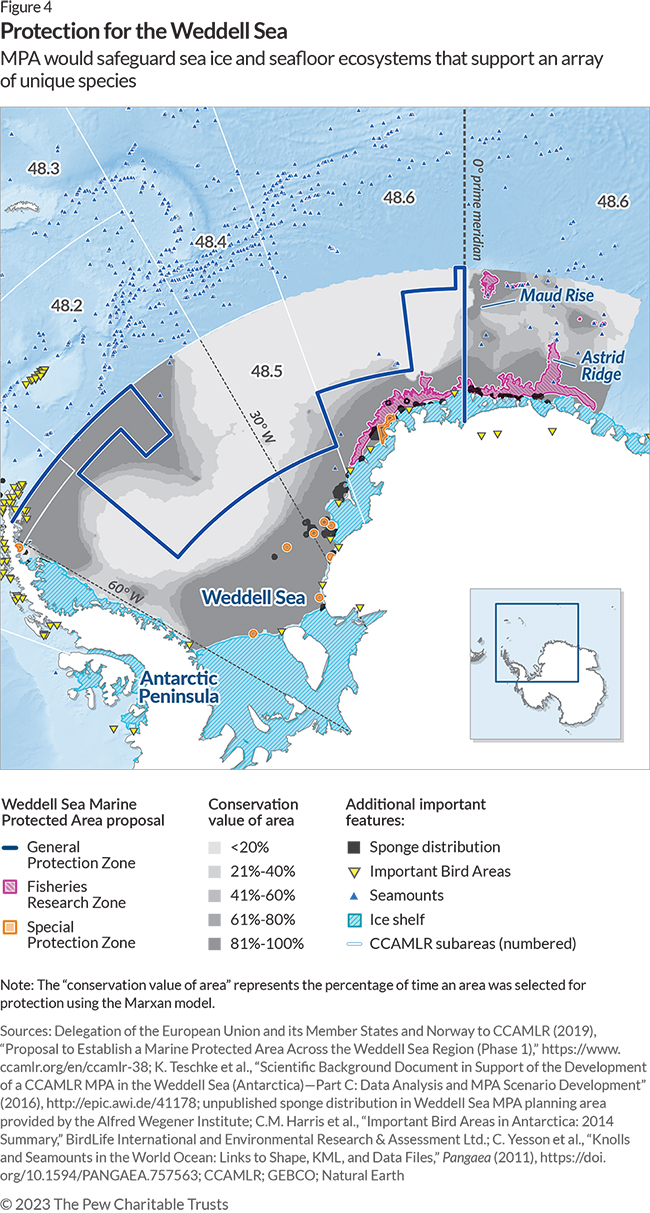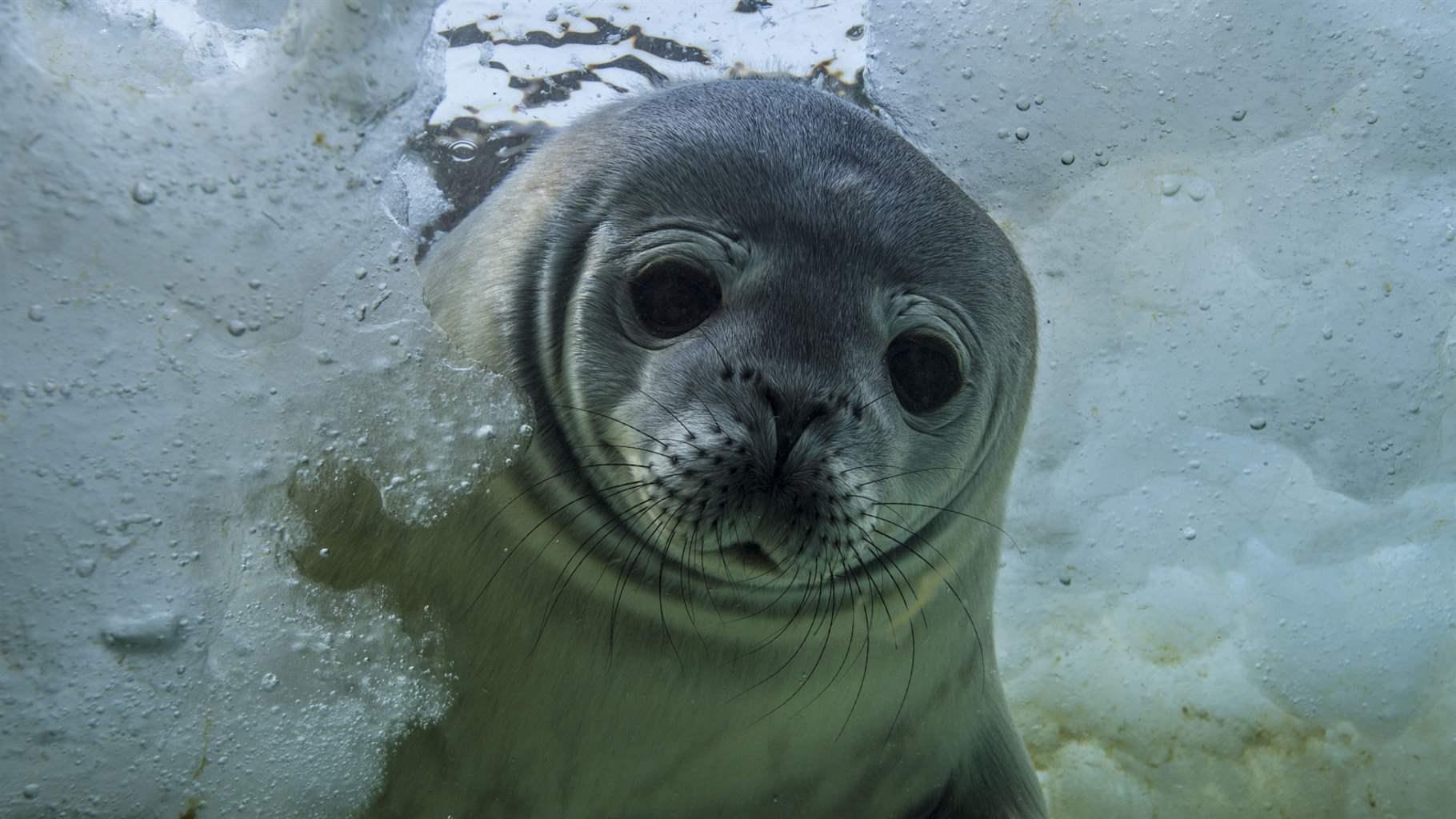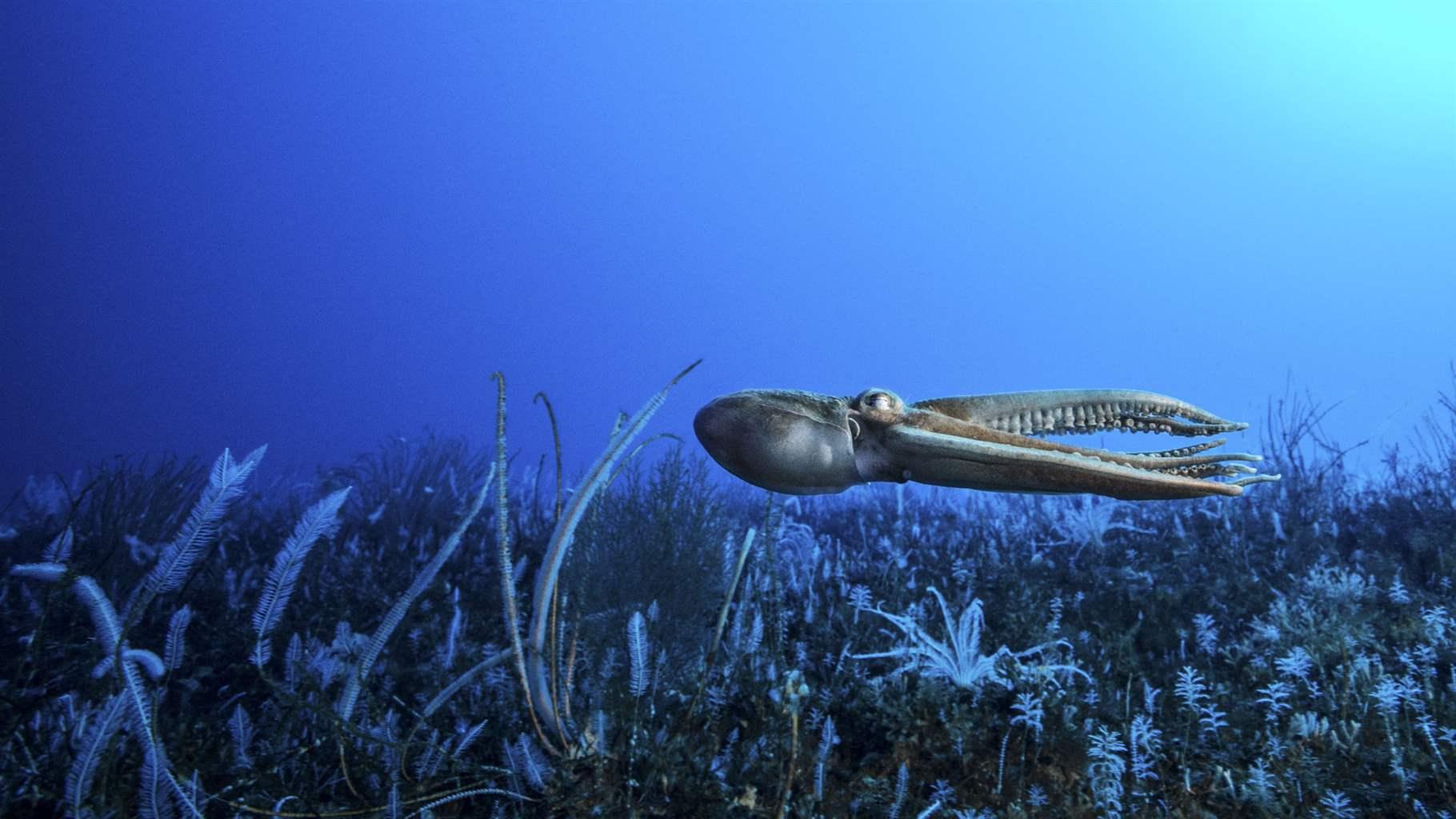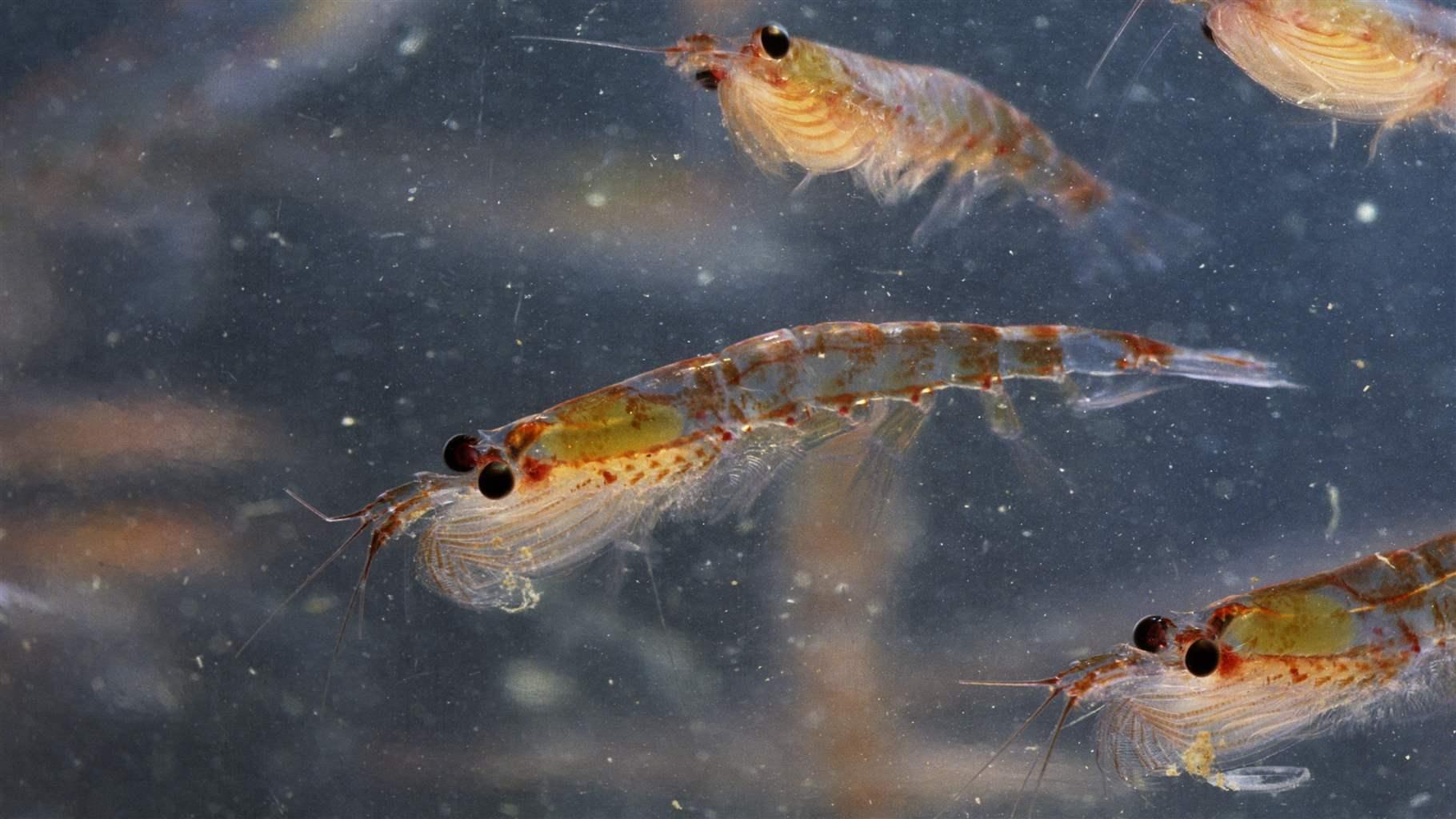The Need for a Network of Marine Protected Areas in the Southern Ocean
Why one of Earth’s last great wilderness areas should be protected
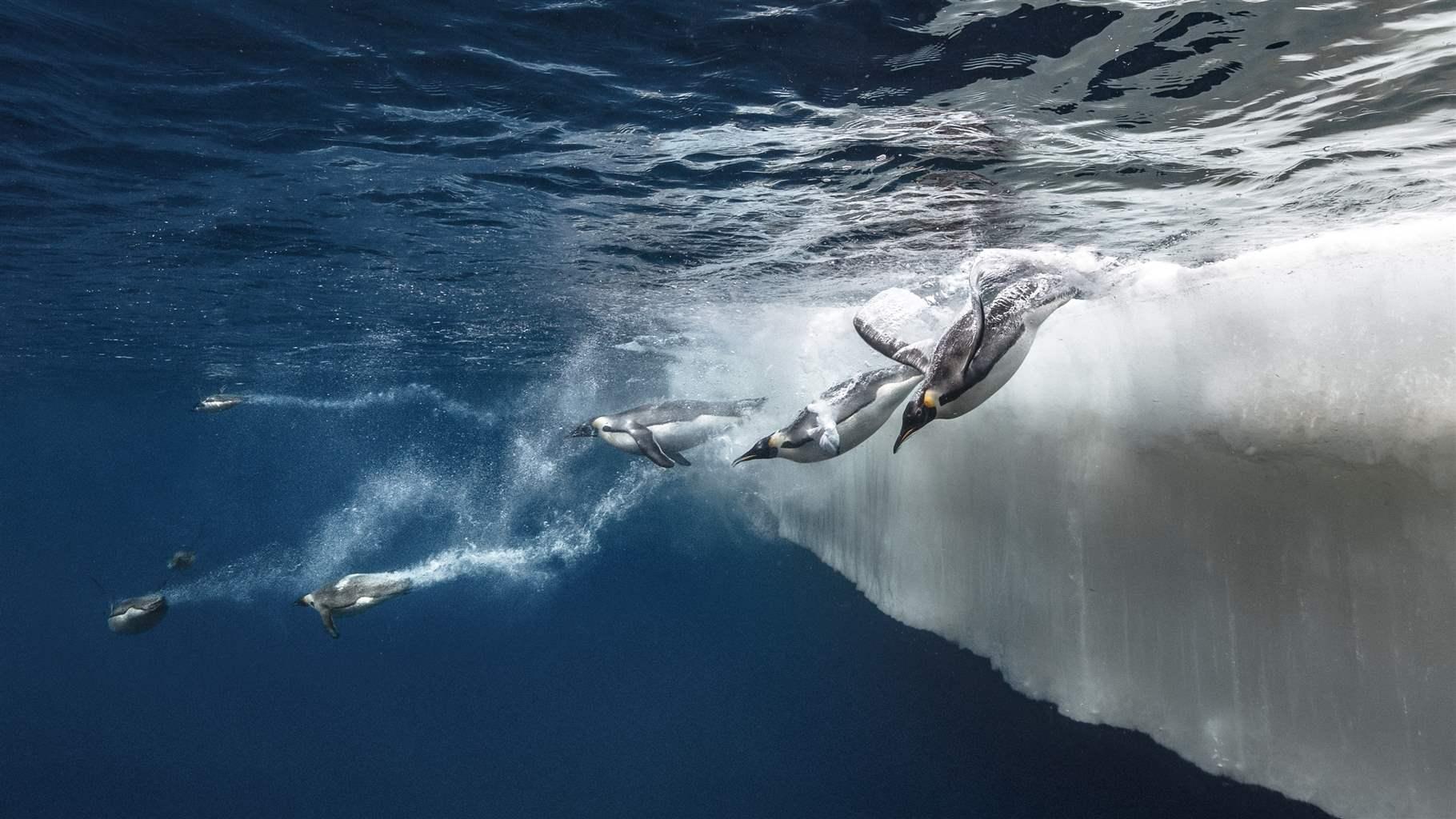
Note: This brief was updated in May 2023 to include the planning domain for the Weddell Sea Marine Protected Area Phase II proposal.
Overview
The Southern Ocean is one of the least-altered marine ecosystems on Earth. Encompassing 10% of the world’s ocean, this region surrounding Antarctica is home to thousands of species found nowhere else, from colossal squid and fish with antifreeze proteins in their blood, to bioluminescent worms and brilliantly hued starfish. It is also home to millions of predators, including penguins, seals, and whales that depend on large swarms of Antarctic krill, small crustaceans that form the base of a delicate food web. These waters are vital to the health of the planet, producing strong upwelling currents that carry critical nutrients north of the equator and, in concert with the rest of the ocean, play a role in regulating the climate.
Climate change and industrial fishing are fundamentally altering this unique region. Species highly evolved to the extreme environment are threatened as changing ocean and atmospheric conditions alter their habitat and disrupt the functions of the marine ecosystem. These impacts are compounded by fishing, which in the case of krill is increasingly concentrated in smaller areas, posing a threat to the animals that rely on this keystone species—and to the biodiversity of the region.
To protect this spectacular region, The Pew Charitable Trusts and its partners are working with the Commission for the Conservation of Antarctic Marine Living Resources (CCAMLR) and its member governments to encourage the adoption of ecosystem-based fisheries management practices and the establishment of a network of largescale marine protected areas (MPAs) around Antarctica.
Fishing in the Southern Ocean
Governments established CCAMLR in 1982 in response to the growing fleet of vessels around Antarctica that were catching krill, which are used to make omega-3 supplements, aquaculture feed, and as fishing bait. While prioritizing conservation—particularly when the best available science is limited or unclear—CCAMLR allows limited fishing in some areas in accordance with its ecosystem-based management approach. The Antarctic krill fishery is now CCAMLR’s largest. The international body, made up of 25 countries and the European Union, also oversees fisheries for Antarctic toothfish (Dissostichus mawsoni) and Patagonian toothfish (Dissostichus eleginoides), marketed as Chilean sea bass, that are spread around the continent.
Table 1
CCAMLR’s fisheries catch for 2017-18
| Fishery | Catch (metric tons) | Region |
|---|---|---|
| Antarctic krill | 312,743 | Atlantic sector: CCAMLR Area 48, encompassing the Antarctic Peninsula, South Orkney, and South Georgia |
| Toothfish (Chilean sea bass) | 2,594 | Atlantic sector: CCAMLR Area 48, particularly South Georgia, South Sandwich, and the Bouvet region |
| 3,474 | Pacific sector: CCAMLR Area 88, including the eastern and western Ross Sea and the Amundsen Sea | |
| 9,751 | Southern Indian Ocean sector: CCAMLR Area 58, particularly near Wilkes Land, Prydz Bay, Banzare Bank, Kerguelen, McDonald, Heard, Crozet, and Marion-Edward | |
| Mackerel icefish | 1 | South Atlantic sector |
| 520 | Indian Ocean sector: Heard Island |
Source: The Commission for the Conservation of Antarctic Marine Living Resources, “Fishery Reports” (2018), https://www.ccamlr.org/en/publications/fishery-reports
The threat of climate change
The health of the Southern Ocean is driven by changes to the ocean itself—such as acidification1 and changes in sea-ice concentration and duration2—and shifts on land that affect marine species, such as heat waves and extreme weather. These waters account for much of this century’s heat gain in the ocean’s upper water column, and warming is also occurring in the region’s deep ocean.3 In response to these impacts, the threat of new and invasive species in the Southern Ocean is growing,4 while endemic marine species have experienced historic dieoffs5 and are shifting their ranges.6
Studies show that MPAs can help vulnerable ecosystems build resilience to climate change by eliminating additional stresses such as fishing.7 Having greater resilience means that ecosystems can better resist and recover from shocks associated with changing ocean conditions, responding to these disturbances while maintaining viable functions. Networks of MPAs also help species adapt to climate change, or the ability to evolve or change behaviors in relation to shifts in habitat conditions, by creating protected pathways for species migrations and range shifts.8 In addition, their relatively undisturbed waters provide a natural laboratory for studying how intact marine ecosystems react to a warming and acidifying ocean.
MPA network: Greater than the sum of its parts
CCAMLR’s primary mission is to protect the Southern Ocean’s diverse marine life. In 2002, CCAMLR became the first international body to commit to creating a network of MPAs, following recommendations from the United Nations World Summit on Sustainable Development. Nine years later, its member governments agreed to Conservation Measure 91-04,9 a framework for creating such a network, and identified nine planning domains for future MPAs.10 At the time, CCAMLR had already established a protected area for the South Orkney Islands southern shelf (2009), the world’s first high-seas MPA. In 2016, it created another MPA—the world’s largest—in the Ross Sea region. Combined, the MPAs cover 2.2 million square kilometers. Additional proposals are under consideration for East Antarctica, the Weddell Sea, and the Antarctic Peninsula.
A network of MPAs would not only preserve connectivity among the Southern Ocean’s many unique ecosystems, allowing marine life to migrate between protected areas for breeding and foraging, but it would also significantly contribute to global ocean protection goals:
- Scientists believe that at least 30% of the global ocean needs to be set aside as MPAs to achieve effective conservation outcomes and help rebuild and manage depleted fish stocks,11 a goal given added urgency by the threat of climate change.12
- To be successful, an MPA should be large, isolated, well enforced, and long lasting, and it should prohibit any extraction of fish or other resources.13 MPAs that meet these criteria create a spillover effect, improving the health of marine life in waters outside of the MPA boundaries.14
- In addition, networks of MPAs that protect migratory pathways and key habitats can ensure that populations are connected, which would build resilience in a changing environment.15
The proposed East Antarctica marine protected area would safeguard 970,000 square kilometers of near-pristine ocean wilderness in the MacRobertson, Drygalski, and D’Urville Sea-Mertz areas.17 Coastal currents, including the Prydz Bay Gyre, mingle with the Antarctic Circumpolar Current, supporting abundant marine life throughout the Southern Ocean.18 Penguins, seals, krill, and toothfish are among the many species that rely on this relatively unexplored, remote, and frigid habitat for survival.19
The proposed MPA is multiple use, with highly protected areas (toothfish no-take zones and a krill no-take zone) as well as areas for fishing in accordance with CCAMLR conservation measures. Targeted research fishing would be permitted in designated research zones within the MPA. Fishing also would be allowed to continue outside the protected area. From the 1972-73 fishing season until the 1994-95 season,20 fishing for Antarctic krill was common in the East Antarctic until all krill fishing became concentrated in the Antarctic Peninsula region. Commercial fishing is limited in the region now, with a small amount of fishing for Antarctic krill, as well as Patagonian and Antarctic toothfish. Establishing an East Antarctic MPA would safeguard critical habitat for its unique biodiversity.
Antarctic Peninsula waters are home to abundant marine life: orcas and humpback whales, fur and crabeater seals, as well as the approximately 1.5 million pairs of Adélie, chinstrap, and gentoo penguins that nest and forage here.23 The fishery for Antarctic krill focuses its operations in this area, overlapping with predators that rely on swarms of krill as a primary food source.24 As temperatures continue to rise, sea ice—habitat for penguins, seals, and other species—is shrinking.25 Krill also rely on sea ice for breeding, and juveniles feed off dense seasonal algae that grow beneath it. Research shows that cumulative stresses of climate change and concentrated fishing are already having negative impacts on the region’s food web.26
The Antarctic Peninsula (Domain 1) Marine Protected Area proposal includes a General Protection Zone27 that covers two biologically rich areas—the Bransfield and Gerlache Straits—and would prohibit krill fishing in the coastal foraging ranges of Antarctic predators. It also protects a part of the Bellingshausen Sea that is an important spawning and nursery area for krill, and other ecologically significant areas for commercially valuable fish species. The Krill Fishing Zone would allow for commercial krill fishing for member nations, managed under CCAMLR’s conservation measures. CCAMLR is working to advance ecosystem-based fisheries management to ensure the long-term survival of the fishery and protect the numerous species that depend on Antarctic krill.
CCAMLR is considering a proposal to create a marine reserve in the Weddell Sea covering more than 2.2 million square kilometers.30 This span of the Southern Ocean is a remote, ice-covered coastal sea with a unique habitat known for its outstanding biodiversity, including Antarctic petrels, emperor and Adélie penguins, and multiple species of seals and whales.31 Far below the sea ice, the nutrient-rich seafloor (benthic) ecosystems form key habitat for an array of creatures found nowhere else on Earth, such as glass sponges and cold-water corals.32
The proposed Weddell Sea MPA contains three zones. The General Protection Zone would be closed to commercial fishing to maintain the health of this ecosystem, protect biodiversity, boost climate resilience, as well as support research and monitoring to improve understanding of the climate and human impacts on Antarctic ecosystems. The Fisheries Research Zone allows for clearly defined research activities, aimed at informing the science-based management of the region’s Antarctic toothfish stock. This includes a better understanding of population structure and life history, biological parameters, and ecology. Part of this zone will remain unfished and will serve as a scientific reference area for analyzing the wider ecosystem effects of fishing. The Special Protection Zone prohibits all fishing in order to protect multiple nesting sites for bottom-dwelling fish and unique, rare, or endemic habitats, especially in the shelf area where rich sponge communities exist. This zone also allows scientists the opportunity to monitor the impacts of natural variability and long-term changes on Antarctic marine living resources.
Sub-Antarctic and Domain 9 MPAs
CCAMLR MPA Planning Domain 9 (Bellingshausen and Amundsen Seas) is the only area in the Southern Ocean that does not have an MPA designated or proposed within its boundaries. Additionally, the regions between the national MPAs in Domains 4, 5, and 6 can be further protected by a CCAMLR MPA that increases connectivity between these critical habitats.
To create a true network of MPAs and deliver the scientifically supported conservation and resilience benefits of an MPA network, CCAMLR member nations should develop MPA proposals within these regions. Collaboration between CCAMLR member nations, stakeholders, scientists, and industry to identify areas of ecological importance within these domains will help CCAMLR meet its goal of creating a robust network of MPAs in the Southern Ocean.
Looking ahead
Creating a network of MPAs in the Southern Ocean would exemplify global cooperation in the face of increasing environmental challenges. After establishing the world’s only high seas MPAs in the South Orkney Islands southern shelf and the Ross Sea, CCAMLR can achieve this goal by also designating MPAs in the Weddell Sea, East Antarctic, and Antarctic Peninsula (Domain 1) and developing additional protections for the Domain 9 and sub-Antarctic regions.
Endnotes
- E.M. Jones et al., “Ocean Acidification and Calcium Carbonate Saturation States in the Coastal Zone of the West Antarctic Peninsula,” Deep Sea Research Part II: Topical Studies in Oceanography139 (2017): 181-94, http://www.sciencedirect.com/science/article/pii/S0967064517300243.
- S.E. Stammerjohn et al., “Trends in Antarctic Annual Sea Ice Retreat and Advance and Their Relation to El Niño–Southern Oscillation and Southern Annular Mode Variability,” Journal of Geophysical Research: Oceans 113, no. C3 (2008), https://agupubs.onlinelibrary.wiley.com/doi/abs/10.1029/2007JC004269.
- H.O. Pörtner et al., “IPCC Special Report on the Ocean and Cryosphere in a Changing Climate” (Intergovernmental Panel on Climate Change, 2019), https://www.ipcc.ch/srocc/.
- Ibid.
- Y. Ropert-Coudert et al., “Two Recent Massive Breeding Failures in an Adélie Penguin Colony Call for the Creation of a Marine Protected Area in D’urville Sea/Mertz,” Frontiers in Marine Science 5 (2018):264, https://www.frontiersin.org/articles/10.3389/fmars.2018.00264/full.
- A. Atkinson et al., “Krill (Euphausia Superba) Distribution Contracts Southward During Rapid Regional Warming,” Nature Climate Change 9, no. 2 (2019): 142-47, https://doi.org/10.1038/s41558-018-0370-z.
- K. Allard et al., “Report of the Study Group on Designing Marine Protected Area Networks in a Changing Climate (SGMPAN)” (2010).
- The International Union for Conservation of Nature, “Marine Protected Areas and Climate Change: Adaptation and Mitigation Synergies, Opportunities and Challenges” (2016), https://portals.iucn.org/library/sites/library/files/documents/2016-067.pdf; E. Sala and S. Giakoumi, “No-Take Marine Reserves Are the Most Effective Protected Areas in the Ocean,” ICES Journal of Marine Science 75 (2017).
- Commission for the Conservation of Antarctic Marine Living Resources, “General Framework for the Establishment of CCAMLR Marine Protected Areas,” https://www.ccamlr.org/en/measure-91-04-2011.
- Commission for the Conservation of Antarctic Marine Living Resources, “Marine Protected Areas (MPAs),” accessed July 31, 2020, https://www.ccamlr.org/en/science/marine-protected-areas-mpas.
- B.C. O’Leary et al., “Effective Coverage Targets for Ocean Protection,” Conservation Letters 9, no. 6 (2016): 398-404, https://conbio.onlinelibrary.wiley.com/doi/abs/10.1111/conl.12247.
- C.M. Roberts, B.C. O’Leary, and J.P. Hawkins, “Climate Change Mitigation and Nature Conservation Both Require Higher Protected Area Targets,” Philosophical Transactions of the Royal Society B: Biological Sciences 375: 20190121, no. 1794 (2020), https://royalsocietypublishing.org/doi/abs/10.1098/rstb.2019.0121.
- G.J. Edgar et al., “Global Conservation Outcomes Depend on Marine Protected Areas With Five Key Features,” Nature 506, no. 7487 (2014): 216-20, https://doi.org/10.1038/nature13022.
- J.R. Beddington et al., “The Role of Marine Reserves in Achieving Sustainable Fisheries,” Philosophical Transactions of the Royal Society B: Biological Sciences 360, no. 1453 (2005): 123-32, https://royalsocietypublishing.org/doi/abs/10.1098/rstb.2004.1578.
- K. Boerder, A. Bryndum-Buchholz, and B. Worm, “Interactions of Tuna Fisheries With the Galápagos Marine Reserve,” Marine Ecology Progress Series 585 (2017).
- Australian Antarctic Division, “A Marine Protected Area for East Antarctica,” last modified Aug. 15, 2018, http://www.antarctica.gov.au/law-and-treaty/ccamlr/marine-protected-areas; B. Raymond et al., “Important Marine Habitat Off East Antarctica Revealed by Two Decades of Multi-Species Predator Tracking,” Ecography 38, no. 2 (2014): 121–29, doi:10.1111/ecog.01021.
- Delegation of the European Union and Its Member States and Australia, “Proposal to Establish an East Antarctic Marine Protected Area” (CCAMLR, 2019), https://www.ccamlr.org/en/ccamlr-38/21.
- S. Nicol, K. Meiners, and B. Raymond, “BROKE-West, a Large Ecosystem Survey of the South West Indian Ocean Sector of the Southern Ocean, 30 Degrees E-80 Degrees E (CCAMLR Division 58.4.2),” Deep-Sea Research Part II: Topical Studies in Oceanography 57 (2010): 693-700, https://www.researchgate.net/publication/248417470_BROKE-West_a_large_ecosystem_survey_of_the_South_West_Indian_Ocean_sector_of_the_Southern_Ocean_30_degrees_E-80_degrees_E_CCAMLR_Division_5842.
- B. Raymond et al., “Important Marine Habitat Off East Antarctica Revealed by Two Decades of Multi-Species Predator Tracking,” Ecography 38, no. 2 (2015): 121-29, https://onlinelibrary.wiley.com/doi/abs/10.1111/ecog.01021; S. Kawaguchi et al., “Krill Demography and Large-Scale Distribution in the Western Indian Ocean Sector of the Southern Ocean (CCAMLR Division 58.4.2) in Austral Summer of 2006,” Deep Sea Research Part II: Topical Studies in Oceanography 57, no. 9 (2010): 934-47, http://www.sciencedirect.com/science/article/pii/S0967064509003993; D. Agnew et al., “Status of the Coastal Stocks of Dissostichus Spp. in East Antarctica (Divisions 58.4.1 and 58.4.2),” CCAMLR Science Journal of the Scientific Committee and the Commission for the Conservation of Antarctic Marine Living Resources 16 (2009): 71-100.
- Commission for the Conservation of Antarctic Marine Living Resources, “Krill Fisheries,” accessed July 30, 2020, https://www.ccamlr.org/en/fisheries/krill-fisheries.
- C.M. Harris et al., “Important Bird Areas in Antarctica: 2014 Summary,” BirdLife International and Environmental Research & Assessment Ltd.; BirdLife International, “Proposed Marine Important Bird and Biodiversity Areas for Antarctic Penguin Species” (2020), manuscript in preparation; Commission for the Conservation of Antarctic Marine Living Resources, “CCAMLR VME Registry,” accessed March 30, 2020, https://www.ccamlr.org/en/document/data/ccamlr-vme-registry.
- Delegations of Argentina and Chile to CCAMLR (2019), “Revised Proposal for a Conservation Measure Establishing a Marine Protected Area in Domain 1 (Western Antarctic Peninsula and South Scotia Arc),” https://www.ccamlr.org/en/ccamlr-38/25-rev-1; Delegations of Argentina and Chile to CCAMLR, “Domain 1 Marine Protected Area Preliminary Proposal Part A-2: MPA Model,” last modified Oct. 13, 2017, https://www.ccamlr.org/en/sc-camlr-xxxvi/18.
- H.W. Ducklow et al., “Marine Pelagic Ecosystems: The West Antarctic Peninsula,” Philosophical Transactions of the Royal Society B: Biological Sciences 362, no. 1477 (2007): 67-94, https://royalsocietypublishing.org/doi/abs/10.1098/rstb.2006.1955.
- J.T. Hinke et al., “Identifying Risk: Concurrent Overlap of the Antarctic Krill Fishery With Krill-Dependent Predators in the Scotia Sea,” PLOS ONE 12, no. 1 (2017): e0170132, https://doi.org/10.1371/journal.pone.0170132.
- 25Pörtner et al., “IPCC Special Report.”
- G.M. Watters, J.T. Hinke, and C.S. Reiss, “Long-Term Observations From Antarctica Demonstrate That Mismatched Scales of Fisheries Management and Predator-Prey Interaction Lead to Erroneous Conclusions About Precaution,” Scientific Reports 10, no. 1 (2020): 2314. https://doi.org/10.1038/s41598-020-59223-9.
- Delegations of Argentina and Chile to CCAMLR, “Revised Proposal for a Conservation Measure Establishing a Marine Protected Area in Domain 1 (Western Antarctic Peninsula and South Scotia Arc)” (CCAMLR, 2019), https://www.ccamlr.org/en/ccamlr-38.
- D.G. Ainley et al., “Geographic Structure of Adélie Penguin Populations: Overlap in Colony-Specific Foraging Areas,” Ecological Monographs 74, no. 1 (2004): 159-178, http://dx.doi.org/10.1890/02-4073; A. Lynnes et al., “Conflict or Co-Existence? Foraging Distribution and Competition for Prey Between Adélie and Chinstrap Penguins,” Marine Biology 141, no. 6 (2002): 1165-74, http://dx.doi.org/10.1007/s00227-002-0899-1; K. Barlow et al., “Are Penguins and Seals in Competition for Antarctic Krill at South Georgia?” Marine Biology 140, no. 2 (2002): 205-13, http://dx.doi.org/10.1007/s00227-001-0691-7; C.M. Harris et al., “Important Bird Areas in Antarctica: 2014 Summary,” BirdLife International and Environmental Research & Assessment Ltd.; L. Krüger, “Spatio-Temporal Trends of the Krill Fisheries in the Western Antarctic Peninsula and Southern Scotia Arc,” Fisheries Management and Ecology 26, no. 4 (2019): 1-7, https://doi.org/10.1111/fme.12363.
- Delegation of the European Union and its Member States and Norway to CCAMLR (2019), “Proposal to Establish a Marine Protected Area Across the Weddell Sea Region (Phase 1),” https://www.ccamlr.org/en/ccamlr-38; K. Teschke et al., “Scientific Background Document in Support of the Development of a CCAMLR MPA in the Weddell Sea (Antarctica)—Part C: Data Analysis and MPA Scenario Development” (2016), http://epic.awi.de/41178; unpublished sponge distribution in Weddell Sea MPA planning area provided by the Alfred Wegener Institute; C.M. Harris et al., “Important Bird Areas in Antarctica: 2014 Summary,” BirdLife International and Environmental Research & Assessment Ltd.; C. Yesson et al., “Knolls and Seamounts in the World Ocean: Links to Shape, KML, and Data Files,” Pangaea (2011), https://doi.org/10.1594/PANGAEA.757563.
- Delegation of the European Union and Its Member States and Norway to CCAMLR, “Proposal to Establish a Marine Protected Area Across the Weddell Sea Region (Phase 1)” (CCAMLR, 2019), https://www.ccamlr.org/en/ccamlr-38.
- C.R. Joiris, “Summer At-Sea Distribution of Seabirds and Marine Mammals in Polar Ecosystems: A Comparison Between the European Arctic Seas and the Weddell Sea, Antarctica,” Journal of Marine Systems 27, no. 1 (2000): 267-76, http://www.sciencedirect.com/science/article/pii/S0924796300000725.
- L. Federwisch, N. Owsianowski, and C. Richter, “Glass Sponge Environments in the Weddell Sea, Antarctica” (YOUMARES 5, 2014), https://epic.awi.de/id/eprint/36662/; A. Brandt et al., “First Insights Into the Biodiversity and Biogeography of the Southern Ocean Deep Sea,” Nature 447, no. 7142 (2007): 307-11, https://doi.org/10.1038/nature05827.
